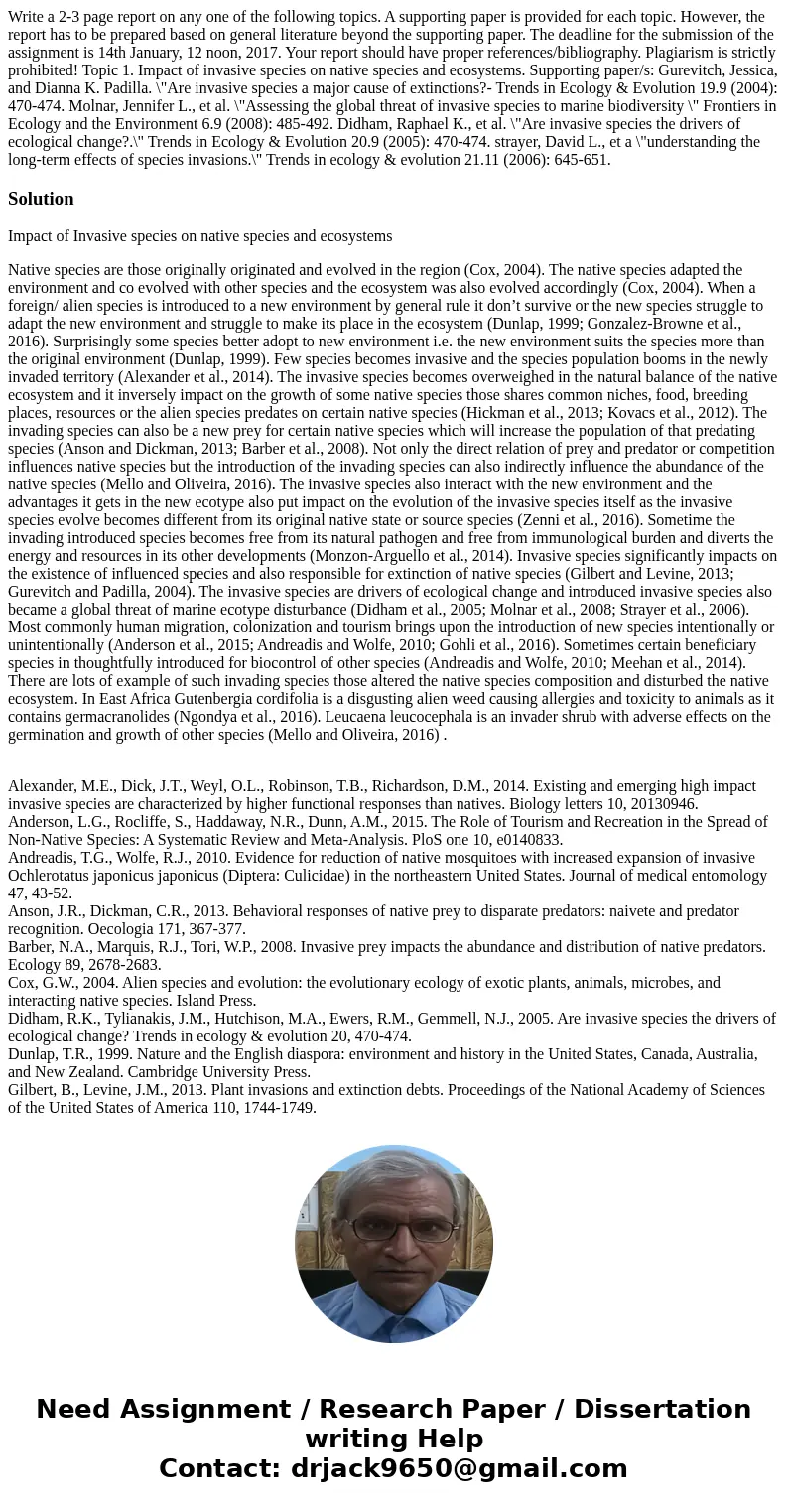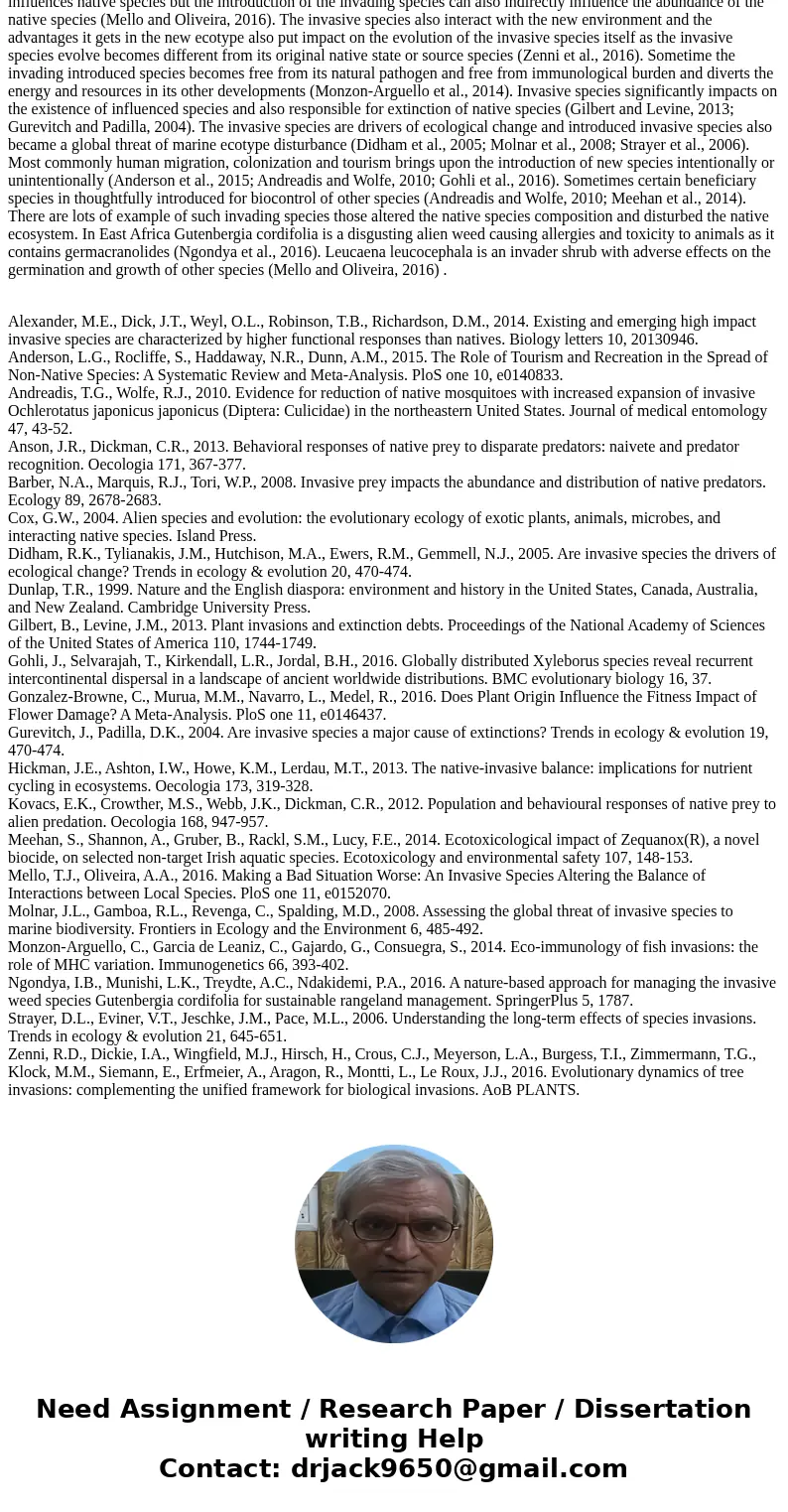Write a 23 page report on any one of the following topics A
Solution
Impact of Invasive species on native species and ecosystems
Native species are those originally originated and evolved in the region (Cox, 2004). The native species adapted the environment and co evolved with other species and the ecosystem was also evolved accordingly (Cox, 2004). When a foreign/ alien species is introduced to a new environment by general rule it don’t survive or the new species struggle to adapt the new environment and struggle to make its place in the ecosystem (Dunlap, 1999; Gonzalez-Browne et al., 2016). Surprisingly some species better adopt to new environment i.e. the new environment suits the species more than the original environment (Dunlap, 1999). Few species becomes invasive and the species population booms in the newly invaded territory (Alexander et al., 2014). The invasive species becomes overweighed in the natural balance of the native ecosystem and it inversely impact on the growth of some native species those shares common niches, food, breeding places, resources or the alien species predates on certain native species (Hickman et al., 2013; Kovacs et al., 2012). The invading species can also be a new prey for certain native species which will increase the population of that predating species (Anson and Dickman, 2013; Barber et al., 2008). Not only the direct relation of prey and predator or competition influences native species but the introduction of the invading species can also indirectly influence the abundance of the native species (Mello and Oliveira, 2016). The invasive species also interact with the new environment and the advantages it gets in the new ecotype also put impact on the evolution of the invasive species itself as the invasive species evolve becomes different from its original native state or source species (Zenni et al., 2016). Sometime the invading introduced species becomes free from its natural pathogen and free from immunological burden and diverts the energy and resources in its other developments (Monzon-Arguello et al., 2014). Invasive species significantly impacts on the existence of influenced species and also responsible for extinction of native species (Gilbert and Levine, 2013; Gurevitch and Padilla, 2004). The invasive species are drivers of ecological change and introduced invasive species also became a global threat of marine ecotype disturbance (Didham et al., 2005; Molnar et al., 2008; Strayer et al., 2006). Most commonly human migration, colonization and tourism brings upon the introduction of new species intentionally or unintentionally (Anderson et al., 2015; Andreadis and Wolfe, 2010; Gohli et al., 2016). Sometimes certain beneficiary species in thoughtfully introduced for biocontrol of other species (Andreadis and Wolfe, 2010; Meehan et al., 2014). There are lots of example of such invading species those altered the native species composition and disturbed the native ecosystem. In East Africa Gutenbergia cordifolia is a disgusting alien weed causing allergies and toxicity to animals as it contains germacranolides (Ngondya et al., 2016). Leucaena leucocephala is an invader shrub with adverse effects on the germination and growth of other species (Mello and Oliveira, 2016) .
Alexander, M.E., Dick, J.T., Weyl, O.L., Robinson, T.B., Richardson, D.M., 2014. Existing and emerging high impact invasive species are characterized by higher functional responses than natives. Biology letters 10, 20130946.
Anderson, L.G., Rocliffe, S., Haddaway, N.R., Dunn, A.M., 2015. The Role of Tourism and Recreation in the Spread of Non-Native Species: A Systematic Review and Meta-Analysis. PloS one 10, e0140833.
Andreadis, T.G., Wolfe, R.J., 2010. Evidence for reduction of native mosquitoes with increased expansion of invasive Ochlerotatus japonicus japonicus (Diptera: Culicidae) in the northeastern United States. Journal of medical entomology 47, 43-52.
Anson, J.R., Dickman, C.R., 2013. Behavioral responses of native prey to disparate predators: naivete and predator recognition. Oecologia 171, 367-377.
Barber, N.A., Marquis, R.J., Tori, W.P., 2008. Invasive prey impacts the abundance and distribution of native predators. Ecology 89, 2678-2683.
Cox, G.W., 2004. Alien species and evolution: the evolutionary ecology of exotic plants, animals, microbes, and interacting native species. Island Press.
Didham, R.K., Tylianakis, J.M., Hutchison, M.A., Ewers, R.M., Gemmell, N.J., 2005. Are invasive species the drivers of ecological change? Trends in ecology & evolution 20, 470-474.
Dunlap, T.R., 1999. Nature and the English diaspora: environment and history in the United States, Canada, Australia, and New Zealand. Cambridge University Press.
Gilbert, B., Levine, J.M., 2013. Plant invasions and extinction debts. Proceedings of the National Academy of Sciences of the United States of America 110, 1744-1749.
Gohli, J., Selvarajah, T., Kirkendall, L.R., Jordal, B.H., 2016. Globally distributed Xyleborus species reveal recurrent intercontinental dispersal in a landscape of ancient worldwide distributions. BMC evolutionary biology 16, 37.
Gonzalez-Browne, C., Murua, M.M., Navarro, L., Medel, R., 2016. Does Plant Origin Influence the Fitness Impact of Flower Damage? A Meta-Analysis. PloS one 11, e0146437.
Gurevitch, J., Padilla, D.K., 2004. Are invasive species a major cause of extinctions? Trends in ecology & evolution 19, 470-474.
Hickman, J.E., Ashton, I.W., Howe, K.M., Lerdau, M.T., 2013. The native-invasive balance: implications for nutrient cycling in ecosystems. Oecologia 173, 319-328.
Kovacs, E.K., Crowther, M.S., Webb, J.K., Dickman, C.R., 2012. Population and behavioural responses of native prey to alien predation. Oecologia 168, 947-957.
Meehan, S., Shannon, A., Gruber, B., Rackl, S.M., Lucy, F.E., 2014. Ecotoxicological impact of Zequanox(R), a novel biocide, on selected non-target Irish aquatic species. Ecotoxicology and environmental safety 107, 148-153.
Mello, T.J., Oliveira, A.A., 2016. Making a Bad Situation Worse: An Invasive Species Altering the Balance of Interactions between Local Species. PloS one 11, e0152070.
Molnar, J.L., Gamboa, R.L., Revenga, C., Spalding, M.D., 2008. Assessing the global threat of invasive species to marine biodiversity. Frontiers in Ecology and the Environment 6, 485-492.
Monzon-Arguello, C., Garcia de Leaniz, C., Gajardo, G., Consuegra, S., 2014. Eco-immunology of fish invasions: the role of MHC variation. Immunogenetics 66, 393-402.
Ngondya, I.B., Munishi, L.K., Treydte, A.C., Ndakidemi, P.A., 2016. A nature-based approach for managing the invasive weed species Gutenbergia cordifolia for sustainable rangeland management. SpringerPlus 5, 1787.
Strayer, D.L., Eviner, V.T., Jeschke, J.M., Pace, M.L., 2006. Understanding the long-term effects of species invasions. Trends in ecology & evolution 21, 645-651.
Zenni, R.D., Dickie, I.A., Wingfield, M.J., Hirsch, H., Crous, C.J., Meyerson, L.A., Burgess, T.I., Zimmermann, T.G., Klock, M.M., Siemann, E., Erfmeier, A., Aragon, R., Montti, L., Le Roux, J.J., 2016. Evolutionary dynamics of tree invasions: complementing the unified framework for biological invasions. AoB PLANTS.


 Homework Sourse
Homework Sourse